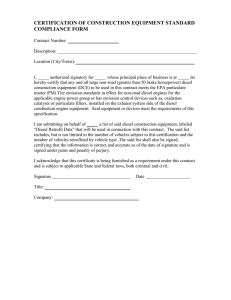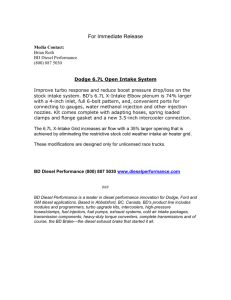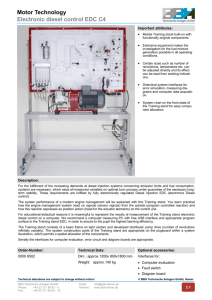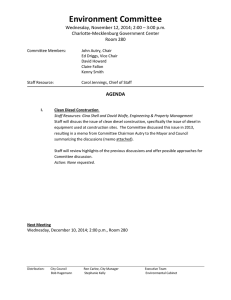The VW emissions scandal:
advertisement
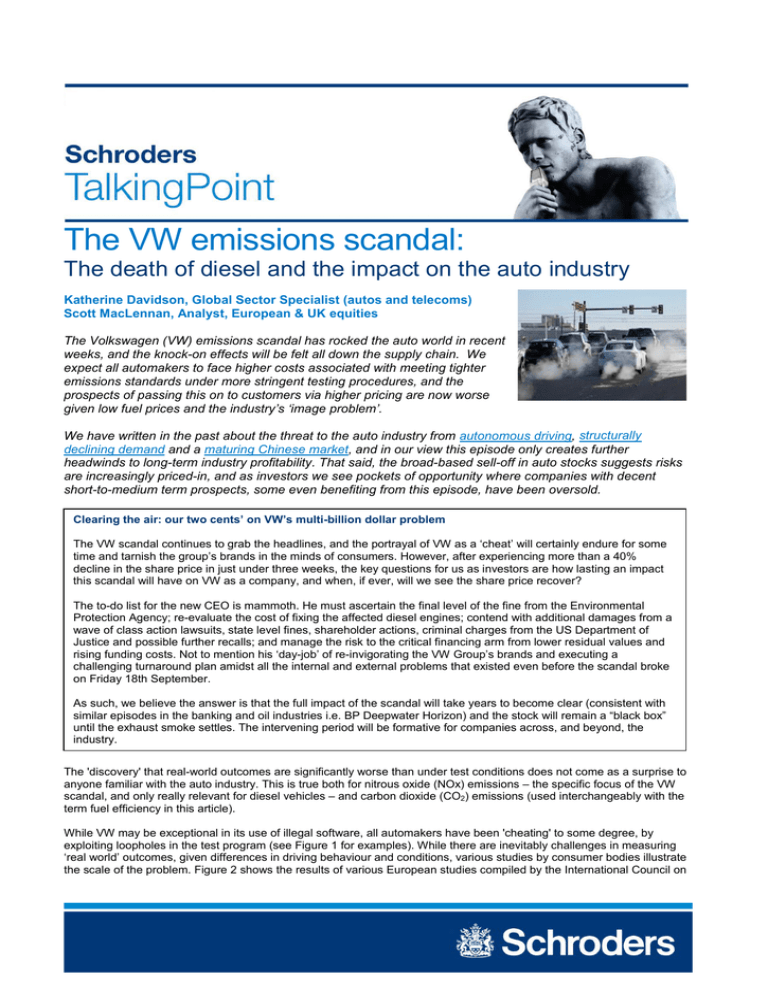
The VW emissions scandal: The death of diesel and the impact on the auto industry Katherine Davidson, Global Sector Specialist (autos and telecoms) Scott MacLennan, Analyst, European & UK equities The Volkswagen (VW) emissions scandal has rocked the auto world in recent weeks, and the knock-on effects will be felt all down the supply chain. We expect all automakers to face higher costs associated with meeting tighter emissions standards under more stringent testing procedures, and the prospects of passing this on to customers via higher pricing are now worse given low fuel prices and the industry’s ‘image problem’. We have written in the past about the threat to the auto industry from autonomous driving, structurally declining demand and a maturing Chinese market, and in our view this episode only creates further headwinds to long-term industry profitability. That said, the broad-based sell-off in auto stocks suggests risks are increasingly priced-in, and as investors we see pockets of opportunity where companies with decent short-to-medium term prospects, some even benefiting from this episode, have been oversold. Clearing the air: our two cents’ on VW’s multi-billion dollar problem The VW scandal continues to grab the headlines, and the portrayal of VW as a ‘cheat’ will certainly endure for some time and tarnish the group’s brands in the minds of consumers. However, after experiencing more than a 40% decline in the share price in just under three weeks, the key questions for us as investors are how lasting an impact this scandal will have on VW as a company, and when, if ever, will we see the share price recover? The to-do list for the new CEO is mammoth. He must ascertain the final level of the fine from the Environmental Protection Agency; re-evaluate the cost of fixing the affected diesel engines; contend with additional damages from a wave of class action lawsuits, state level fines, shareholder actions, criminal charges from the US Department of Justice and possible further recalls; and manage the risk to the critical financing arm from lower residual values and rising funding costs. Not to mention his ‘day-job’ of re-invigorating the VW Group’s brands and executing a challenging turnaround plan amidst all the internal and external problems that existed even before the scandal broke on Friday 18th September. As such, we believe the answer is that the full impact of the scandal will take years to become clear (consistent with similar episodes in the banking and oil industries i.e. BP Deepwater Horizon) and the stock will remain a “black box” until the exhaust smoke settles. The intervening period will be formative for companies across, and beyond, the Test results versus real world outcomes industry. The 'discovery' that real-world outcomes are significantly worse than under test conditions does not come as a surprise to anyone familiar with the auto industry. This is true both for nitrous oxide (NOx) emissions – the specific focus of the VW scandal, and only really relevant for diesel vehicles – and carbon dioxide (CO2) emissions (used interchangeably with the term fuel efficiency in this article). While VW may be exceptional in its use of illegal software, all automakers have been 'cheating' to some degree, by exploiting loopholes in the test program (see Figure 1 for examples). While there are inevitably challenges in measuring ‘real world’ outcomes, given differences in driving behaviour and conditions, various studies by consumer bodies illustrate the scale of the problem. Figure 2 shows the results of various European studies compiled by the International Council on Schroders Talking Point For professional investors or advisers only 1 Clean Transportation (ICCT), showing that ‘real world’ CO2 emissions are typically 40% higher than official emissions . The results for NOx are even worse, with actual emissions orders of magnitude higher than in lab conditions (Figure 3). Figure 1: Beating the system: how carmakers ‘optimise’ CO2 testing Source: T&E report: Mind the Gap! Why official car fuel economy figures don’t match up to reality, published March 2013. Figure 2: CO2 emissions under lab conditions vs. real-world Source: ICCT, 2013 1 ICCT (Sept 2014). From laboratory to road. A 2014 update of official and “real-world” fuel consumption and CO2 values for passenger cars in Europe. 2 Schroders Talking Point For professional investors or advisers only Figure 3: NOx emissions (g/km) from diesel cars under lab conditions vs. real-world N.B. ‘Euro X’ refers to the prevailing emission standards regime, with Euro 6, which came into effect in September 2014, the most stringent. Source: ICCT, Carslaw and Rhys-Tyler, Exane BNP Paribas estimates. While this reflects very poorly on the industry in the public eye, in the automakers' defence, test programs are designed to provide comparable, standardised data in controlled conditions, and the test limits have been set based on the expectation of significant slippage in real world driving. That said, the widening spread between test results and real world outcomes in recent years suggests the OEMs have gotten better at 'gaming' the tests while there has been limited real improvement in vehicle performance, despite tightening emissions standards. Stricter regulations on the horizon As such, the first and clearest implication of this episode, in our view, is that emissions tests will become more stringent, both in terms of the targets the automakers are required to meet and the actual testing process. To some degree, this was already anticipated: as well as tighter emissions targets globally (see Figure 4), there were already tentative plans in Europe to phase-in 'Real-world Driving Environment' (RDE) testing for NOx emissions from 2017 and replace the current 2 3 official NEDC test cycle with WLTC , which is more comparable to actual driving conditions, likely in 2021. While bureaucratic inertia precludes a massive change in the pace of adoption, we would expect to see these moves accelerated where possible, and certainly not delayed, as industry lobbyists had hoped they could be in light of falling oil prices. Figure 4: Global CO2 standards by major market Grams of CO2 per km normalised to NEDC test cycle 240 220 US 200 South Korea 2015: 153 Canada 180 Mexico Mexico 2016: 153 Brazil 2017***: 146 160 140 120 Japan 2020: 105 100 60 2000 China 2020*: 117 India 2021: 113 Canada 2025: 93 EU 2021: 95 80 EU US 2025**: 93 2010 2015 2020 China S Korea India Brazil EU 2025: 68 – 78? 2005 Japan 2025 Source: ICCT, Exane BNP Paribas *China’s target reflects vehicles only. The target may be higher after new energy vehicles are considered. **US standards GHG standards set by EPA, which is slightly different from fuel economy standards due to low-GWP refrigerant credits. ***Gasoline in Brazil contains 22% of ethanol (E22), all data in the chart have been converted to gasoline (E00) equivalent. Supporting data can be found at http://www.theicct.org/info-tools/global-passenger-vehicle-standards 2 3 3 New European Driving Cycle Worldwide Harmonized Light Vehicle Test Procedure Schroders Talking Point For professional investors or advisers only Furthermore, in light of the ‘bad blood’ between regulators and the industry as result of this episode, the details of the new regulations are now likely to include fewer concessions to automakers and make targets much harder to hit in practice. For example, the European Commission had proposed to introduce ‘conformity factors’ (CFs) for RDE NOx testing, effectively allowing real world emissions to continue to exceed the official Euro 6 targets. The whisper number out of Brussels had been as high as 8 times, but there will now be more pressure to adopt lower, or no, CFs, as well as other measures such as randomising test routes to reduce the potential for ‘gaming’. Similarly, the shift from NEDC to WLTP alone is expected to result in around a 10g increase in recorded CO2 emissions for the same vehicle. Before last week, the industry’s base case was that this would be offset by higher (i.e. more lenient) absolute targets, but if this proves politically infeasible it would necessitate a sharp acceleration in the pace of required improvement. We would also expect to see Europe introduce in-service conformity checks for CO2 to ensure that properly maintained vehicles remain compliant over their useful lives. These already exist in the US but, for European OEMs, responsibility for emissions currently ends at the factory gate. Inevitably, tighter emissions regulations and stricter testing will result in a material increase in the cost of compliance for OEMs, which they are less likely to be able to pass on to customers in the current environment (discussed in more detail below). The negative press around this issue, and broader distrust of the industry, could also result in stricter testing procedures in other areas, such as safety. Regulators are already coming under pressure to reduce the practice of relying on self-reported data from the OEMs, and it is easy to see the debate moving in this direction given the number of safetyrelated incidents in recent years. The death of diesel? 4 The other main dimension of this episode is the specific focus on diesel vehicles . Ironically, the VW issue originated in the US, where diesel vehicles account for less than 1% of vehicle sales and VW has been the main champion of diesel 5 with more than 50% market share . As such, diesel is likely to remain a very marginal technology in the US, though this will not have much impact on the global vehicle mix. In Europe, however, diesel vehicles have become the norm, accounting for more than half of total EU car sales. Diesel market share increased steadily from the early 1990s until 2011, largely due to 15-20% higher fuel efficiency, which makes them an attractive proposition for consumers, automakers and governments. Despite the higher up-front cost, the total cost of ownership (TCO) of a diesel car is lower than a petrol model beyond 5000 miles per year in the UK, and even better in countries where lower fuel taxes mean the retail price of diesel is lower than petrol. However, diesels have become a victim of their own success. The corollary of better fuel efficiency is higher NOx emissions, and their increased popularity has resulted in rising total NOx levels in urban areas despite significant declines in emissions per vehicle. This has provoked a broader backlash against diesels in recent years, with several cities proposing to ban older diesel vehicles and tax regimes becoming less supportive. Furthermore, improving fuel efficiency for gasoline engines, combined with the rising cost of meeting tighter NOx standards, have made diesels less economical for consumers and automakers. As such, diesel sales have already been declining in most countries in recent years. While this episode has stimulated much discussion of the 'death of diesel', it is more accurate to speak of the (less catchy) acceleration of its ongoing demise. Figure 5: Western Europe diesel mix Source: LMC Automotive, September 2015. 4 Despite the fact that gasoline vehicles also performed badly on real-world CO2 tests in the surveys compiled by the ICCT. ICCT (Sept 2015), NOX control technologies for Euro 6 Diesel passenger cars: Market penetration and experimental performance assessment. 5 4 Schroders Talking Point For professional investors or advisers only We do not believe that diesel will go to zero in the foreseeable future. LMC (an industry consultancy) expects diesel to decline from 52% of Western European car sales year-to-date to around 44% by 2022, or 39% in their worst case scenario with rising anti-diesel sentiment and regulatory sanctions (Figure 5). Admittedly, this ‘worst case’ was envisaged before the VW scandal, so there is scope for even faster decline, but we expect that better fuel efficiency will continue to make diesels attractive to some customers, especially for larger vehicles. More importantly, there would be significant manufacturing challenges associated with a dramatic shift in fleet powertrain mix, and automakers are reliant on a reasonably high diesel mix to meet 2021 CO2 targets. Figure 6 shows that a reduction in diesel market share to zero by 2020 would create a CO2 headwind of almost 20g/km, with an associated cost of several hundred euros per vehicle. Figure 6: Impact of declining diesel mix on CO2 emissions EU CO2 g/km tailwind (headwind) from diesel adoption to 2020E Source: Exane BNP Paribas estimates. However, should diesels fall out of favour with customers as a result of the VW scandal, or governments take further efforts to discourage their purchase, the premium that automakers have been able to charge for diesel vehicles will shrink to the extent that it no longer covers the higher content cost versus petrol vehicles (which can run to more than $1500 per 6 car) to achieve full Euro 6 compliance (Figure 7) . They may even have to offer incentives to buy diesel models, such as up-front discounts and residual value guarantees, and invest in marketing to highlight the benefits of Euro 6 diesels. All of this will clearly be negative for profitability. Declining demand will also impact the value of diesels in the used car market, which could force carmakers to take impairment charges in their financial services arms for cars sold on lease contracts, and reduce their profits from used car sales. Figure 7: Estimated cost per vehicle of emissions reduction technologies NB. LHS shows European NOx standards; RHS shows US standards In $ 1,800 1,600 1,400 1,200 1,000 Gasoline 800 Diesel 600 Diesel w/o deNOX 400 200 0 Euro 1 Euro 2 Euro 3 Euro 4 Euro 5 Euro 6 Tier 1 NLEV Tier 2 B5 Source: Exane BNP Paribas estimates Increasing electrification likely The corollary is that alternative powertrains will become a relatively more attractive way of meeting emissions targets. We would expect to see increasing electrification of the powertrain, from adding ‘micro’ or ‘mild’ hybrid content to normal gasoline engines, to higher sales of full and plug-in hybrid vehicles and (less so) pure battery electrics. 6 Note that this is not a technology issue: the technology necessary to achieve full compliance under real world conditions is already on the market, as demonstrated by the fact that vehicles fitted with the most expensive NOx-control technologies performed well in the ICCT study. 5 Schroders Talking Point For professional investors or advisers only Today, high battery costs mean that these vehicles are not attractive for customers from a TCO point of view, except in some countries where subsidies are very generous. However, it is important to recognise that the TCO equation is essentially in the control of carmakers, and it may be necessary for them to shoulder (even bigger) losses on hybrids and electrics to meet emissions targets. Over time, higher production will also reduce the cost of components such as batteries, which may happen faster than expected if penetration runs ahead of prior expectations. We would also expect to see government policies move further in favour of ‘green’ vehicles, given emissions are fast becoming a political issue. We envisage measures such as more widespread tax incentives and government-funded roll-outs charging infrastructure, potentially funded by higher taxes on diesels and even fines on the auto industry. Investment implications for the auto industry: 1. Declining industry profitability The combination of stricter testing and falling pricing power on more efficient diesel vehicles will make it much harder (read: more expensive) to meet future CO2 targets. The cost of meeting 2021 targets was already expected to run to 7 €1500-2000 per vehicle, and will be higher if the market shifts away from diesel and towards electrification . With most mass-market companies making thin margins – perhaps €500 per car in a good year – a step up in the pace and degree of emissions reduction will have a significant impact on earnings. Furthermore, the fact that OEMs will now be required to move faster than originally anticipated, in the context of a normal 5-7 year model cycle, may require them to use suboptimal, more expensive, methods, and a near-term bump in demand for certain parts may cause prices to rise (benefiting suppliers). Industry insiders also anticipate a scrum for the best engineering and consulting talent, causing labour costs to rise as well as content and R&D costs. The prospect of being able to pass these higher costs on to customers looks poor, given low oil prices and the industry’s current image problem. In all, the next few years are likely to be very challenging for industry profitability, particularly alongside headwinds from normalising profitability in China and rising competition in a plateauing US market. 2. Hastened structural challenges In the long term, we see this scandal creating a further headwind for the auto industry, which we already expected to experience structural challenges because of demographics, autonomous driving, and ‘disruptive mobility’ models such as Uber and car clubs. Higher awareness of residual value risk – preying on the minds of diesel owners today – may also reduce the desire for personal vehicle ownership. More fundamentally, much as the Lehman shock and subsequent scandals in the banking industry ushered in new entrants (pay-day and peer-to-peer lenders; mobile money), we believe this episode may erode the value of car brands, clearing the way for challengers such as Tesla and potentially Google or Apple. Among car companies, we believe premium marques will be more resilient, due to their higher brand value and pricing power, higher margins, and technology leadership. Mass-market automakers, especially those with high European and diesel exposure, will be particularly challenged. This is likely to accelerate consolidation, or at very least further collaboration, between automakers (though admittedly this did not help VW, who have been the most active consolidators). 3. Outlook for suppliers more positive, but depends on product portfolio The outlook for suppliers is more nuanced, and depends on the components they produce and the customers they serve. In the near-term, suppliers of emissions-reduction technology for internal combustion engines (such as catalytic converters, gasoline direct-injection and turbochargers) should benefit as automakers scrabble to meet near-term targets without dramatically altering their current powertrain mix. However, in the medium-term, the outlook is more negative as internal combustion engines, in particular diesel, gradually lose share to hybrids, electrics and possibly even fuel cells. Many of the companies with the highest exposure to vehicle electrification are not typical auto suppliers, but semi-conductor and electronics companies. Also, while the balance of power has shifted in favour of suppliers over the most recent cycle, it is hard to see them escaping unscathed as their customers’ profitability comes under ever greater pressure. Suppliers exposed to areas unrelated to emissions, such as advanced driver assistance systems (ADAS) and connectivity, are best-positioned medium-term, as carmakers will continue to add content in an attempt to appeal to increasingly reticent consumers and maintain pricing power. 7 E.g. Redburn (November 2014), The Biggest Issue: CO2 and ICCT (November 2012), Summary of the EU cost curve development methodology. 6 Schroders Talking Point For professional investors or advisers only Impact on the catalyst market Dan McFetrich (Global Sector Specialist: industrials) Diesel car engines are very lucrative end markets for catalyst companies, with the content per vehicle on a diesel 4 to 5 times higher than the gasoline equivalent given the need for catalysts in NOx-control technologies*. The rising diesel share in Europe until recently (discussed above) and ongoing tightening in NOx emissions standards has thus benefitted catalyst companies, with the latest Euro 6 standards being dramatically tougher than the prior Euro 4 and 5 on both particulates (PMs) and NOX (Figure 8). Figure 8: Euro 6 standards require significant improvements in NOx emissions Progression of Diesel Emissions Standards PM Emissions (mg/km) 30 Euro 4 25 20 15 10 Euro 6 5 Euro 5 0 0 50 100 150 200 250 NOx Emissions (mg/km) Source: Johnson Matthey As discussed, we expect diesel to lose share in Europe as a result of the VW scandal, both due to ‘image problems’ and more stringent testing pushing up their cost relative to gasoline vehicles. Due to the lower content per vehicle on gasolines (even lower on hybrids and zero on electrics), this shift will be detrimental for catalyst companies. One offset could come from new ‘Euro 6c’ regulations coming in next year for gasoline direct injection engines, which will double the gasoline content per vehicle due to the requirement for new particulate filters. Furthermore, given vehicle production cannot shift rapidly towards gasoline and carmakers need diesel to meet CO2 targets, catalyst companies should realise a short-term benefit as more automakers add more sophisticated NOx-control technologies to diesel cars to meet stricter testing. We could even see a retrofit cycle in Europe if some older diesels are required to upgrade their NOx-control systems, for example to be allowed to drive in Paris and London. However, higher volumes may be accompanied by poorer profitability, as declining pricing power on diesels leads to a margin squeeze across the value chain. In conclusion, we would expect a mixed outcome for catalyst companies, with a lower diesel mix being offset to some extent by upgrades to higher-priced technologies, a potential retrofit cycle, and gasoline direct injection benefits in 2017. Tougher emissions standards in emerging markets could also provide some respite. * The most effective and popular technologies for NOx control are lean NOx traps (LNT) and selective catalytic reduction (SCR), both of which contain catalysts to ‘catch’ NOx and convert it into other, less harmful, gases. Catalysts also help with reduce PMs via diesel particulate filters. Impact on platinum Owen Scarrott (Global Sector Specialist: energy and materials) One metal’s loss is another’s gain – at least in the case of platinum and palladium. Whereas platinum is used for diesel catalytic converters, palladium is used for converters in gasoline engines. All else equal, a move away from diesel to gasoline cars is therefore positive for palladium, so it is not surprising that palladium has outperformed platinum since the VW news broke. That said, all was not well for platinum even before the scandal: the demand outlook and price performance has already been weakened by surpluses and lower-than-expected production of catalytic converters. Meanwhile, supply has been slow to adjust due to labour market inflexibility and economic weakness in South Africa, where the largest platinum miners are located. The long-term bear argument on demand is well rehearsed: a gradual move away from internal combustion engines will result in structural decline in demand for platinum group metals. While we agree that continued uncertainty about diesel demand and the rise of alternative powertrains will likely weigh on the sector, we do not believe that platinum is dead (yet). Firstly, as discussed above, there could be a near-term increase in demand for catalytic converters due to the slow demise of diesel and tighter emission standards worldwide. Furthermore, eventual supply cuts could rebalance the market and lead to better pricing. Hydrogen fuel cells – currently a major area of investment for automakers – also provide a potentially sizeable new market in the longer term. The other area of potential interest in metals is lithium, given faster uptake of hybrid and electric vehicles should increase demand for lithium-ion batteries. In the broader commodities space, it goes without saying that a faster-than-expected decline in internal combustion engines, and potentially car ownership more generally, is structurally negative for oil demand, given transportation accounts for over half of global oil consumption. Again, there could again be a short-term fillip from a mix-shift towards gasoline, as lower fuel efficiency implies higher total fuel consumption. 7 Schroders Talking Point For professional investors or advisers only Important information: The views and opinions contained herein are those of Katherine Davidson, Global Sector Specialist (Global and International Equities), Scott MacLennan, Analyst (European & UK equities), Dan McFetrich, Global Sector Specialist (Global and International Equities) and Owen Scarrott, Global Sector Specialist (Global and International Equities), and may not necessarily represent views expressed or reflected in other Schroders communications, strategies or funds. The sectors and securities mentioned above are for illustrative purposes only and are not to be considered a recommendation to buy or sell. Past performance is not a guide to future performance and may not be repeated. The value of investments and the income from them may go down as well as up and investors may not get back the amounts originally invested. Exchange rate changes may cause the value of any overseas investments to rise or fall. The forecasts included should not be relied upon, are not guaranteed and are provided only as at the date of issue. Our forecasts are based on our own assumptions which may change. We accept no responsibility for any errors of fact or opinion and assume no obligation to provide you with any changes to our assumptions or forecasts. Forecasts and assumptions may be affected by external economic or other factors. This document is intended to be for information purposes only and it is not intended as promotional material in any respect. The material is not intended as an offer or solicitation for the purchase or sale of any financial instrument. The material is not intended to provide, and should not be relied on for, accounting, legal or tax advice, or investment recommendations. Information herein is believed to be reliable but Schroder Investment Management Ltd (Schroders) does not warrant its completeness or accuracy. No responsibility can be accepted for errors of fact or opinion. This does not exclude or restrict any duty or liability that Schroders has to its customers under the Financial Services and Markets Act 2000 (as amended from time to time) or any other regulatory system. Issued by Schroder Unit Trusts Limited, 31 Gresham Street, London, EC2V 7QA. Registered Number 4191730 England. Authorised and regulated by the Financial Conduct Authority. For your security, communications may be taped or monitored. 8
